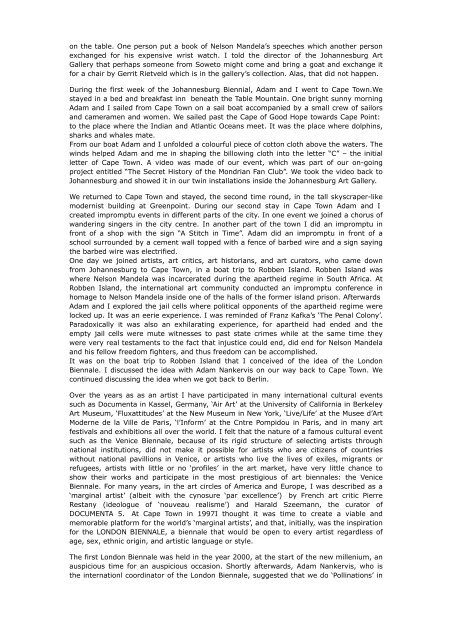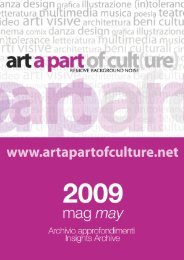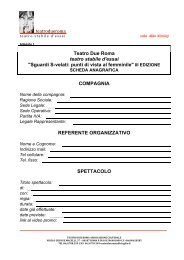Scarica | Download - art a part of cult(ure)
Scarica | Download - art a part of cult(ure)
Scarica | Download - art a part of cult(ure)
Create successful ePaper yourself
Turn your PDF publications into a flip-book with our unique Google optimized e-Paper software.
on the table. One person put a book <strong>of</strong> Nelson Mandela’s speeches which another person<br />
exchanged for his expensive wrist watch. I told the director <strong>of</strong> the Johannesburg Art<br />
Gallery that perhaps someone from Soweto might come and bring a goat and exchange it<br />
for a chair by Gerrit Rietveld which is in the gallery’s collection. Alas, that did not happen.<br />
During the first week <strong>of</strong> the Johannesburg Biennial, Adam and I went to Cape Town.We<br />
stayed in a bed and breakfast inn beneath the Table Mountain. One bright sunny morning<br />
Adam and I sailed from Cape Town on a sail boat accompanied by a small crew <strong>of</strong> sailors<br />
and cameramen and women. We sailed past the Cape <strong>of</strong> Good Hope towards Cape Point:<br />
to the place where the Indian and Atlantic Oceans meet. It was the place where dolphins,<br />
sharks and whales mate.<br />
From our boat Adam and I unfolded a colourful piece <strong>of</strong> cotton cloth above the waters. The<br />
winds helped Adam and me in shaping the billowing cloth into the letter “C” – the initial<br />
letter <strong>of</strong> Cape Town. A video was made <strong>of</strong> our event, which was p<strong>art</strong> <strong>of</strong> our on-going<br />
project entitled “The Secret History <strong>of</strong> the Mondrian Fan Club”. We took the video back to<br />
Johannesburg and showed it in our twin installations inside the Johannesburg Art Gallery.<br />
We returned to Cape Town and stayed, the second time round, in the tall skyscraper-like<br />
modernist building at Greenpoint. During our second stay in Cape Town Adam and I<br />
created impromptu events in different p<strong>art</strong>s <strong>of</strong> the city. In one event we joined a chorus <strong>of</strong><br />
wandering singers in the city centre. In another p<strong>art</strong> <strong>of</strong> the town I did an impromptu in<br />
front <strong>of</strong> a shop with the sign “A Stitch in Time”. Adam did an impromptu in front <strong>of</strong> a<br />
school surrounded by a cement wall topped with a fence <strong>of</strong> barbed wire and a sign saying<br />
the barbed wire was electrified.<br />
One day we joined <strong>art</strong>ists, <strong>art</strong> critics, <strong>art</strong> historians, and <strong>art</strong> curators, who came down<br />
from Johannesburg to Cape Town, in a boat trip to Robben Island. Robben Island was<br />
where Nelson Mandela was incarcerated during the ap<strong>art</strong>heid regime in South Africa. At<br />
Robben Island, the international <strong>art</strong> community conducted an impromptu conference in<br />
homage to Nelson Mandela inside one <strong>of</strong> the halls <strong>of</strong> the former island prison. Afterwards<br />
Adam and I explored the jail cells where political opponents <strong>of</strong> the ap<strong>art</strong>heid regime were<br />
locked up. It was an eerie experience. I was reminded <strong>of</strong> Franz Kafka’s ‘The Penal Colony’.<br />
Paradoxically it was also an exhilarating experience, for ap<strong>art</strong>heid had ended and the<br />
empty jail cells were mute witnesses to past state crimes while at the same time they<br />
were very real testaments to the fact that injustice could end, did end for Nelson Mandela<br />
and his fellow freedom fighters, and thus freedom can be accomplished.<br />
It was on the boat trip to Robben Island that I conceived <strong>of</strong> the idea <strong>of</strong> the London<br />
Biennale. I discussed the idea with Adam Nankervis on our way back to Cape Town. We<br />
continued discussing the idea when we got back to Berlin.<br />
Over the years as as an <strong>art</strong>ist I have p<strong>art</strong>icipated in many international <strong>cult</strong>ural events<br />
such as Documenta in Kassel, Germany, ‘Air Art’ at the University <strong>of</strong> California in Berkeley<br />
Art Museum, ‘Fluxattitudes’ at the New Museum in New York, ‘Live/Life’ at the Musee d’Art<br />
Moderne de la Ville de Paris, ‘l’Inform’ at the Cntre Pompidou in Paris, and in many <strong>art</strong><br />
festivals and exhibitions all over the world. I felt that the nat<strong>ure</strong> <strong>of</strong> a famous <strong>cult</strong>ural event<br />
such as the Venice Biennale, because <strong>of</strong> its rigid struct<strong>ure</strong> <strong>of</strong> selecting <strong>art</strong>ists through<br />
national institutions, did not make it possible for <strong>art</strong>ists who are citizens <strong>of</strong> countries<br />
without national pavillions in Venice, or <strong>art</strong>ists who live the lives <strong>of</strong> exiles, migrants or<br />
refugees, <strong>art</strong>ists with little or no ‘pr<strong>of</strong>iles’ in the <strong>art</strong> market, have very little chance to<br />
show their works and p<strong>art</strong>icipate in the most prestigious <strong>of</strong> <strong>art</strong> biennales: the Venice<br />
Biennale. For many years, in the <strong>art</strong> circles <strong>of</strong> America and Europe, I was described as a<br />
‘marginal <strong>art</strong>ist’ (albeit with the cynos<strong>ure</strong> ‘par excellence’) by French <strong>art</strong> critic Pierre<br />
Restany (ideologue <strong>of</strong> ‘nouveau realisme’) and Harald Szeemann, the curator <strong>of</strong><br />
DOCUMENTA 5. At Cape Town in 1997I thought it was time to create a viable and<br />
memorable platform for the world’s ‘marginal <strong>art</strong>ists’, and that, initially, was the inspiration<br />
for the LONDON BIENNALE, a biennale that would be open to every <strong>art</strong>ist regardless <strong>of</strong><br />
age, sex, ethnic origin, and <strong>art</strong>istic language or style.<br />
The first London Biennale was held in the year 2000, at the st<strong>art</strong> <strong>of</strong> the new millenium, an<br />
auspicious time for an auspicious occasion. Shortly afterwards, Adam Nankervis, who is<br />
the internationl coordinator <strong>of</strong> the London Biennale, suggested that we do ‘Pollinations’ in















